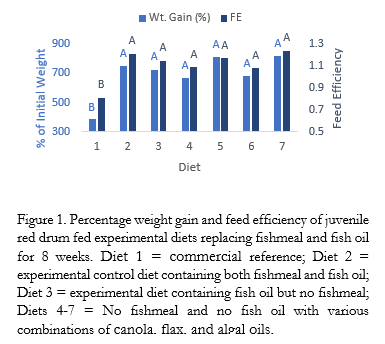EVALUATION OF GROWTH PERFORMANCE, CONDITION INDICES AND BODY COMPOSITION OF JUVENILE RED DRUM Sciaenops ocellatus FED FISHMEAL- AND FISH OIL-FREE DIETS
Global increases in aquaculture production has led to heightened demand and increasing costs of fishmeal and fish oil products for use in the diets of highly carnivorous fish species, such as the red drum. Therefore, viable alternative protein and lipid sources are needed to substantially replace fishmeal and fish oil in commercial diets. In the current study, a commercial reference diet containing 51% crude protein (CP) on a dry-matter basis and six isonitrogenous (50% CP) experimental diets that completely replaced menhaden fishmeal and/or menhaden fish oil were evaluated with juvenile red drum. The experimental control diet (Diet 2) contained menhaden fishmeal at 28.3% of dry weight and 6.5 % menhaden fish oil. Diet 3 had all of the menhaden fishmeal replaced with a combination of peptide product MrFeed Pro50S, poultry by-product meal and soy protein concentrate but contained menhad en fish oil at 7.7% of dry weight . All other experimental diets were isolipidic (13% crude lipid) and contained no fishmeal or fish oil which was replaced by various combinations of canola, flax, and algal oils.
In the comparative feeding trial, groups of 15 fish (~4.4 g/fish initial weight) were stocked in 28, 38-L aquaria fashioned as a recirculating aquaculture system with quadruplicate aquaria randomly assigned to each diet and fed for an 8-week duration. At the end of the trial, juvenile red drum fed the commercial reference diet exhibited significantly (P<0.05) reduced percentage weight gain, fillet yield, feed efficiency (FE), protein conversion efficiency (PCE), and survival compared to fish fed all experimental diets as analyzed by one-way ANOVA (Figure 1). Red drum fed the six experimental diets did not show any significant differences in any growth parameters. Fish fed the commercial reference diet also showed significantly (P<0.05) higher viscerosomatic indices, including hepatosomatic index (HSI) and intraperitoneal fat (IPF) ratio than fish fed most experimental diets that replaced fishmeal and/or fish oil. Whole-body proximate analysis revealed no significant differences in crude protein content; however, red drum fed the commercial diet had a significantly higher ash and lower whole-body lipid composition than fish fed all other diets. The current study provides evidence that juvenile red drum can be successfully raised using practical diets devoid of fishmeal and fish oil.
